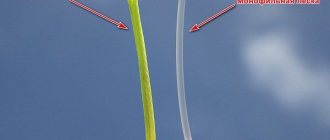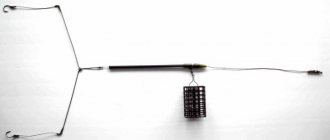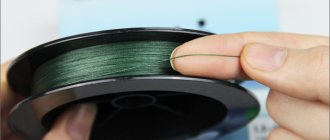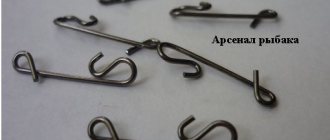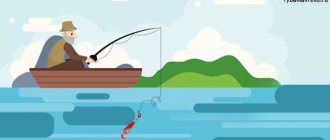In the previous article we talked about fishing with a feeder on the river, now it’s time to reveal such a concept as a feeder on a lake, since fishing with bottom gear, in the absence of a current, makes its own adjustments when choosing a fishing spot, bait, rod and method of mounting equipment. Fishing with a feeder on the lake, of course, is carried out with lighter feeders and delicate gear, while the forms must be quite long in order to be able to fish at depth, which can begin at a considerable distance from the shore, although here there are also exceptions and nuances, so let's figure it out.
Fishing with a feeder on a lake, fish behavior features
Weather
In early spring and late autumn, clear sunny days are the best for fishing; during this period, fish come out to the shallows, where the water warms up faster. With the arrival of the summer heat, the lack of sun activates the fish bite, as the temperature drops slightly. Periodic light rains often delight the fisherman with increased activity of aquatic life and a good catch. It has also been noted that on the eve of bad weather (several hours before it begins), biting activity increases significantly.
Feeder on the lake influence of wind and temperature
The surface of the lake is quite spacious, there are practically no barriers that would restrain the wind, the exception may be the presence of an island or rock near the shore, but they will not play a significant role. Fishermen have noticed that if the wind blows from the west, south or southwest, then fishing with a feeder on the lake is quite successful and effective, but if the wind direction is north (this is relevant in the autumn-spring period) and is marked by a significant cooling, then the peaceful fish become more sluggish and in no hurry to attack your bait. The influence of wind depends on the size of the lake and the presence of natural barriers, so on a large lake, changes in wind affect the bite faster than on a small forest lake protected by trees growing along the banks.
The presence of wind can also influence the choice of place for feeder fishing on the lake, since the waves generated under its influence begin to erode the shores and carry various larvae and worms into the water, which in turn attracts carp, roach, silver bream, and bream to such places. Capes along which there is a surf wave are considered especially catchy.
Fans of feeder fishing should also monitor the water temperature, since in the summer, in the absence of wind, the water in the lake warms up greatly, but does not mix, which leads to the formation of a thermocline
(a section through which the water temperature changes sharply). The fish do not stand on the thermocline itself, because, like us, they do not like sudden changes in temperature. She tries to stay near him without crossing the line, and if the angler has found a thermocline, then he has a great chance of catching. When a thermocline forms on a lake during the heat, you should not look for fish in deep holes, since there is little oxygen there and aquatic inhabitants behave rather sluggishly; often during this period, fishing with a feeder on the lake is effective just above the thermocline line, where there is plenty of oxygen and the temperature slightly less than at the surface.
Seaweed
Feeder on a lake means fishing in the presence of aquatic vegetation, which significantly affects the bite. After all, some plants serve as food and shelter, while others are uninteresting or even harmful. The scourge of all stagnant reservoirs and reservoirs with weak currents is the period of flowering of small algae (greenweed), which clog the gills of fish and reduce oxygen in the upper layers of water, sometimes this even leads to pestilence. At this time, fishing with a feeder on the lake will be more effective in areas where springs come out of the ground, or where rivers and streams flow into the lake. If the lake is not covered with green grass, then during the day you should look for fish at the edge of the algae, in windows and clearings; in the late afternoon, it moves from there to open areas.
The fish prefers to stay in thickets of soft algae, but among hard ones it can only be found in the first weeks of summer.
Bait when fishing on a feeder
For bait I used a sandwich of several bloodworms and maggots. Note that the hook point is left open. With the bait set this way, the fish are less likely to get stuck, so if someone else is covering the sting, stop believing the old wives' tales that the fish sees it and doesn't take the bait.

I also tried fishing with a worm, corn and pearl barley - there were no bites. I then added all this to the bait.

Of course, the worm had to be cut into pieces, but I didn’t take scissors, and I didn’t want to waste time cutting it with a knife. Maggot and bloodworms were also added to the bait - the wisdom “what you feed, catch it” has not been canceled.
Everything seems to be ready. You can start fishing.
Feeder on the lake choosing a fishing spot
The lakes are rich in fish, but it is not evenly distributed on them; often schools choose certain areas and stick to them, so fishing with a feeder on the lake will be successful only if you find fishing spots.
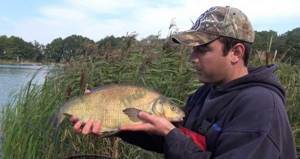
Here, just like on the river, the law of opposites operates. If the reservoir is heavily covered with vegetation, then the fish will stay in open areas, and vice versa, among clear water surfaces, the fish tries to accumulate near places where there is vegetation or near snags and trees that have fallen into the water. Promising places for lake fishing are islands and channels between them, as well as areas where the current borders on standing water. As for the bottom topography, the fish stays on edges, slopes, depressions, various underwater ridges or moves along them.
Depth sounding
Arriving at an unknown body of water, you need to find the edge on which the fish is standing. Due to the fact that the lake has a rather complex topography, it may have several edges, and most will lead to even greater depths. Which edge the fish will stand on depends on the weather conditions. The edge is the area where the bottom topography breaks, the upper part of the break is the upper edge, the lower part, which turns into a gentle descent or rise, is the lower edge, respectively. Basically, the fish prefers to stand on the lower edge, this is where the feeder on the lake will be most effective; the fish comes to the upper edge in the late afternoon (if it is warm summer days).
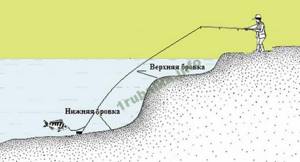
It makes no sense to fish on the slope of the edge itself, since the feeder will roll off it, and you will not be able to create a normal feeding spot.
Determination of bottom relief
On reservoirs densely and evenly overgrown with reeds, the edge can be determined visually. Reeds grow at a depth of up to two meters, and if you see how the strip of reeds ends abruptly and is followed by a clear water surface, then you have found the beginning of the edge.
But that’s not all, because to successfully fish with a feeder on the lake, we need to find the bottom edge. Why take a weight and a braided fishing line (it has better sensitivity than a monk). We throw out the tackle and start reeling, if the weight goes effortlessly, and then we feel noticeable resistance, it means there is a lift here (the beginning of the lower edge).
If the load falls through or hangs, then in this place the bottom is uneven and there are various holes; the fish also does not ignore such areas. While reeling in, we simultaneously determine the type of bottom; on a rocky and shell-covered bottom, the load moves with noticeable shaking; on hard ground, smoothly and easily; on muddy ground, a slight tension is felt. You can also measure the bottom topography using a marker float.
Casting
To fix the casting distance, it is better to use a marker, for which we mark an area on the fishing line with a length of 50-100 cm, and then periodically update the marking, since after a while it will be erased. You can fix the line with a clip only when catching small fish (roach, silver bream, small crucian carp), since in case of a large fish biting, due to the fixation of the line, neither the clutch nor the bittrainer will work. If the lake is not too wide, then on the opposite shore you need to choose a landmark (tree, bush, pole) in order to cast clearly straight, without errors to the side.
Fishing with a feeder on the lake in hot weather
With the onset of heat, fish from the shallows and tables move to deeper water areas, where the water is cooler, but it is worth remembering that at depth (due to the formation of a thermocline) it may not be caught at all; bites may indicate the formation of a thermocline,
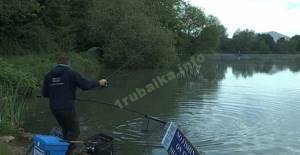
which occur only when lifting and casting the bait. In this case, it is better not to throw the tackle to a depth of more than 2-3 m, but to look for fish among the algae and in the shadow of underwater boulders. Towards evening, in the shallows, where the water is more quickly enriched with oxygen. In the morning and evening hours, feeder fishing on the lake can be successful in places where shade is formed from trees and bushes hanging over the water. Another promising place is areas where cool springs gush out from under the ground or a river (stream) flows into the lake. If the lake is shallow, then the bite may subside completely and not resume even at night and at dawn.
Bait for feeder fishing
As the main bait I used the inexpensive RS Bream .

This bait already contains large fractions that will detain large fish at the fishing point.
I poured the bait into a bucket, added a small amount of water and mixed it with my palm. Do not squeeze the bait into your fist or between your fingers - this will create a bunch of lumps.

You need to add enough water so that after squeezing the bait in your fist, it retains its shape. If you then throw the lump back into the bucket, it should crumble.
The prepared bait must be left for 10 minutes to allow it to swell. After this, it must be rubbed through a sieve to get rid of large lumps and saturate it with oxygen, the bubbles of which will push it out of the feeder at the bottom of the reservoir.
I didn’t have a sieve, so I loosened the large lumps with my hands, and saturated the bait with oxygen by shaking the bucket for several minutes (I came up with this method myself).
An hour has already passed since I arrived at the place, and I haven’t even cast my fishing rod yet. Meanwhile, my friend had been fishing for a long time. Well, since you’ve decided to act according to the rules, you’ll have to wait a little longer.
Rod
Mainly for standing reservoirs, light (picker) class rods are used, designed for feeder weights of up to 25 grams, and medium (middle class) feeder weights of 30-50 grams. Only when it is necessary to cast over the longest distances, should you use rods of a heavier class. Here it is worth remembering that accurate casting can be achieved when fishing at a distance of up to 50 m, and after that, the further we throw the tackle, the greater the scatter we will have and the worse the feeding spot. for using light-test feeder rods is because there is little or no current on the lake and we don't need to put out heavy feeders to fight it. At the same time, the lighter the feeder, the more sensitive the tackle, which will respond to even the weakest bites.
Rods with a length of 3.6-3.9 m are considered universal; they allow you to cast quite far, and at the same time do not hinder the angler when fishing in areas overgrown with vegetation. Rods longer than 3.9 m should be used when you need to sharply lift the feeder from the bottom and move it over the edge or make a long cast. Rods less than 3 m long (mostly pickerel) are used when there is no need to cast far or you fish under overhanging treetops and from a boat.
Feeder on the lake reel selection
Depending on the range of feeder fishing on the lake and the class of the rod, we will need reel spools of different sizes. For fishing close to the shore with pickerel and mediums, we will use reels with a spool size of 1500-2500. When fishing at medium distances up to 30-40 m, the spool size is 2000-3500. When fishing at a distance of over 40 m, it is better to use larger reels with a spool size of 4000 and above. It’s good when the reel comes with a second spool; you can wind braid or a monk of a smaller diameter on it. A good reel must lay the line evenly and evenly, since unevenly laid or overlapping line significantly reduces the casting distance.

bittrainer
The gear ratio for the feeder reel is in the range of 4.7:1-5.2:1; reels with this gear ratio are quite powerful, but their fishing speed is significantly lower. Reels with a gear ratio higher than 5.2:1 should be used when actively fishing with a feeder for small lake fish (roach, rudd, small crucian carp). In order for feeder fishing on the lake to be comfortable, the reel must have at least 4 bearings plus one in the line roller (but don’t be fooled by the large number of bearings in cheap Chinese reels). To use braid, the reel must be coated with titanium nitride.
The feeder reel should also have a rear clutch (it is easier to adjust during fishing) and a bittrainer system (a mechanism that gives the spool free movement). Why do we need it, let’s say we need to move away, and as a rule, it is at this moment that a large fish bites, as a result it can drag away our fishing rod or break the tackle. To prevent this from happening, we will need to loosen the previously so carefully adjusted friction brake or we can simply turn the lever and the line will come off the reel itself.
Choosing a fishing line for feeder fishing on the lake
If you are going to fish at a considerable distance from the shore, it is better to use a braided line, since it has better sensitivity than a monk, and at the same time, when fishing with a pickerel at a distance of 15 m from the shore, it is better to use a monk, especially if you are clipping the line.
Choosing equipment for feeder fishing on the lake
On a stagnant pond, there is not much difference in what shape you use a feeder (cylindrical, square, triangular), with the exception of a feeder on a lake with a muddy bottom, here it is better to take a wide-bodied feeder with minimal weight, for example a “Method” type feeder or a plastic cylindrical feeder with wings .
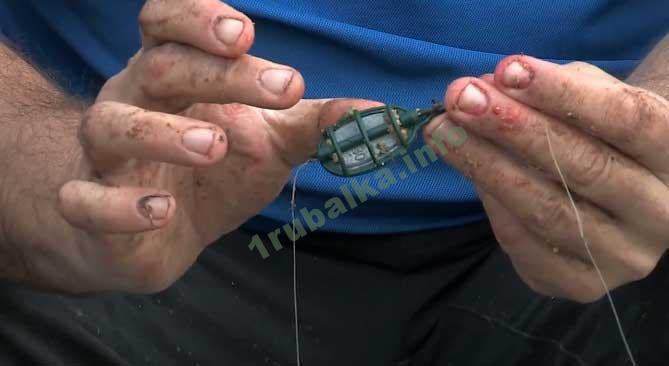
For fishing on a standing reservoir, the following methods of installing feeder equipment :
- The Gardner loop or Paternoster is a very catchy rig, has good sensitivity, and is also used for fishing in currents. Although it is not a self-hooking rig, the fish rarely manages to avoid being hooked;

- Inline (running feeder) when casting over long distances, overlaps are possible, so it is better to use it when fishing at short distances;
- Equipment using a “Method” type feeder. There are two installation methods (inline and blind), the latter being a self-cutting rig. Due to the openness, hooks with bait are hidden in these feeders, and it is used as a nipple, which is why it is very popular in carp fishing.
- The symmetrical loop is a self-cutting device. When fishing on hard ground it has better sensitivity than the paternoster.

- Asymmetrical loop (self-cutting equipment). Fishing with a feeder on a lake using an asymmetrical loop has a number of advantages over symmetry. The first is that when you cast, the feeder does not overlap with the leash, the second has better sensitivity. The asymmetrical loop is not recommended for use on reservoirs with a heavily cluttered bottom.
How to attach a rod
Staying in a boat for a long time often hinders movement and brings certain inconveniences. It is better if the boat is spacious and does not have fixed seats. This will increase the space for placing gear. On the sides there are usually mounts for oarlocks; fishing rods can be placed on them. Fishing from a boat on a lake, I repeat, is better done with one feeder. Two or three rods will already interfere with fishing in a small boat, and it will be difficult to look after them all at the same time.
Fishing on a boat and from the shore to the feeder, you can watch in the video:
Choosing bait for feeder fishing on the lake
If the lake is large, then you may have to lure fish from long distances (200-400 m), so you need a lot of bait. A feeder on a lake is different from fishing on small ponds and stakes; it is quite difficult to overfeed the fish here.
On a large lake, during a strong wind, a wave current can form, which will spread 1-1.5 m deep, due to which we will lose 20-25% of the bait with each cast. It is better to accept such losses than to make the bait more viscous. Bait for feeder fishing in still water should be active and slightly under-moistened. Properly mixed and selected bait should fall out of the feeder on its own as soon as it touches the bottom. This is easy to check, when the feeder touches the bottom, we wait 15-20 seconds and make a hook, at this moment we should feel how the tackle has become lighter, freed from the bait. In this way, we actually carry out the starting feeding, which consists of 10-15 feeders abandoned in a row. For starter feeding, larger and more capacious feeders are used.
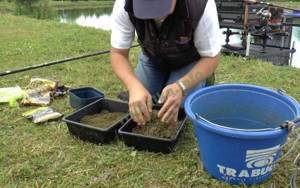
Fishing with a feeder on the lake is successful with bait consisting of small and medium-sized components, which should become very dusty; such bait does not saturate the fish, but when it falls, it seems to explode, which attracts fish (it is good to add molasses to the bait for these purposes) . This works especially effectively in reservoirs with clean and transparent water, where fish can see a cloud of turbidity from afar; often fishermen use earth sifted through a sieve to create turbidity. For fishing in a standing body of water, the bait must contain a significant amount of inert particles that will float to the bottom and attract fish that stand in the water column to the bottom, for example, hemp grains, which are especially effective when catching roach.
Your bait must include animal components (parish, bloodworms, chopped worms), as well as the components you are going to fish with.
For feeder fishing on a small and shallow lake for half a day, you will need 1.5 kg of bait and 0.5-1 kg of live food (if you don’t want to spend too much money, then live food will have to be replaced with plant food, but the effect will be significantly weaker) . When fishing on a large lake in places where the depth is 4 m or more, the amount of dry food needs to be increased to 2.5-3 kg, more is possible, it is difficult to overfeed the fish here.
Flavors
When fishing in warm summer weather, a feeder on a lake at a depth of up to 5 m will be effective if you use sweet flavors with the smell of banana, peach, strawberry, and of course tutti-frutti. These are quite universal scents and are suitable for lake fishing for any peaceful fish. Also, when catching bream and roach, it is worth adding ground coffee and cinnamon bark to the bait. Universal flavorings for catching any representatives of cyprinids are cocoa, caramel, macadamia, and anise.
When fishing with a feeder on a lake in places where a spring comes out of the ground or a cold mountain stream flows into it, as well as when fishing at great depths, where the water temperature is quite low, spicy aromas (coriander, pepper, cinnamon, garlic) will be more effective. .
Selecting tackle for catching bream on the lake
Catching bream using feeder rods on lake-type reservoirs will require a feeder rod, which will be equipped with a reel. According to its length parameters, this rod is selected in such a way that it is equal to three meters if the fishing process is carried out in shallower lake reservoirs. In the case where the depth of the reservoir is more serious, you can choose a fishing rod that is a little longer, from three and a half to four meters.
For this type of bream fishing, you should select feeder rods that will have an extremely sensitive tip, which will be equipped with a bite alarm system.
It is also necessary to select an inertia-free reel, the average parameters of which are around 3000. In addition to all this, this reel is equipped with a bobbin with large volumes, and it is also necessary to have a friction brake on this reel.
The test characteristics of the main fishing lines are around four or five kilos; you should not take a fishing line with thick parameters, so as not to scare away the fish itself. You can use an option such as a braided cord. This type of fishing line material does not have its own memory, and therefore bites will be felt better.
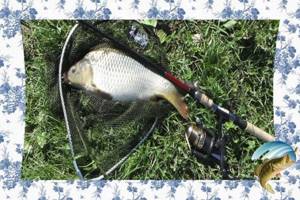
The leashes are made from such a fishing line, the diametric parameters of which are 0.12.014 millimeters. In this case, the value of the length parameter is approximately from twenty to fifty centimeters.
We choose a feeder in favor of round or cylindrical shapes. Weight parameters are about fifty grams. Selection of hooks in favor of an elongated forend, numbers 10-15.
How to catch crucian carp on a feeder
The technique of fishing with a feeder is simple and reminiscent of my grandfather’s old donkey:
- The feeder is filled with bait, and various baits are attached to the hooks.
- The tackle is thrown to the intended fishing spot using a long rod.
- The rod is installed on the stand in such a way that the line coming from the equipment is in tension, transmitting the slightest bite to the sensitive tip.
- Hooking the fish is done with a sharp movement of the rod.
- Fishing is carried out by pulling it to the shore by winding the fishing line with a reel.
Catching crucian carp on a feeder begins, first of all, with choosing a place. To do this, a fisherman, especially on an unfamiliar body of water, needs to determine the bottom topography and find the area where crucian carp will stand at one time or another of the year. For this we use:
- The method of tapping the bottom with a feeder rod equipped with a heavy sinker.
- Wireless echo sounders with sensors that, using the same fishing rod, can be cast a long distance from the shore and, from the image on the device display, determine not only the bottom topography, but also the presence of fish at a particular point. Fishing in this case will guarantee a catch.
After a place has been found, the angler loads bait into the feeders, attaches the bait to the hooks and casts.
As soon as the sinker reaches the bottom and the line slacks, a gentle rotation of the reel handle creates tension in the line and a slight bend in the tip - the tackle is ready for fishing.
The feeders are placed on special stands, which allow you to quickly and easily take the rod from it when biting and make a hook.
